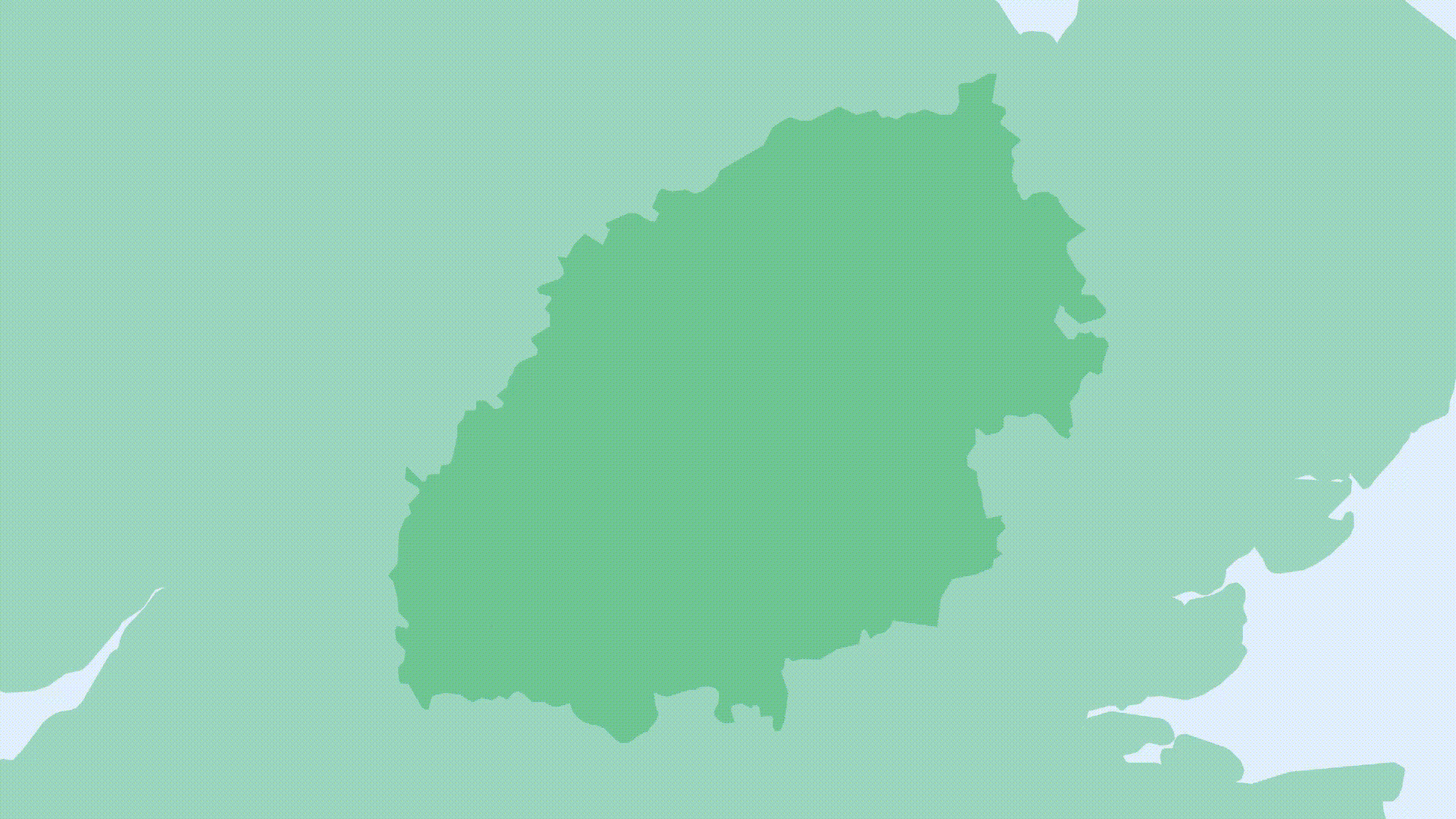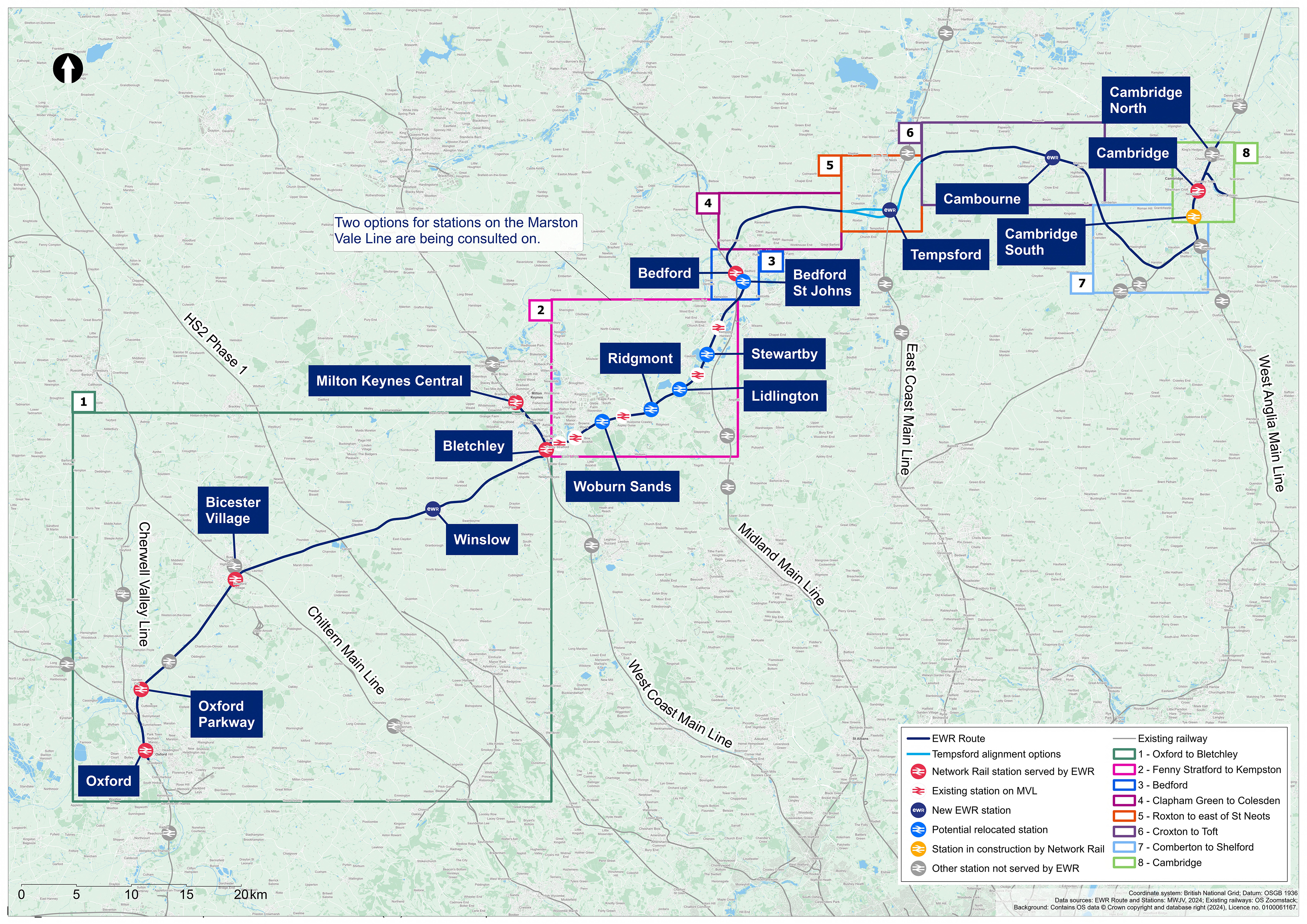IMPORTANT
Our 2024 non-statutory consultation closed on 24 January (23:59) and we are now processing your feedback. Although this consultation is now closed, you can still get in touch with us here. There will also be further opportunities to provide feedback on our updated proposals at our future statutory consultation.
About East West Rail and our 2024 consultation
East West Rail will connect communities between Oxford, Milton Keynes, Bedford and Cambridge, supporting sustainable economic growth in the area. The new railway would make it easier to reach jobs, education, public services and days out with family and friends.
Our 2024 non-statutory consultation is now closed.

Our 2024 non-statutory consultation is now closed.
During the consultation, people could take part and submit crucial feedback by:
- Attending our in-person or online events
- Visiting a virtual consultation room
- Viewing our proposals online and at information points
- Filling in a feedback form

The benefits of East West Rail
For more than 30 years, councillors and business leaders from across the region have been calling for a rail link connecting Oxford and Cambridge.
By making it easier, faster and more affordable to get around the region, the new railway will open up new journeys, cut travel times on public transport, ease congestion on local roads and bring more jobs within reach of people living locally.
The vibrant communities between Oxford, Milton Keynes, Bedford and Cambridge combine beautiful landscapes and a rich cultural heritage with world-famous centres of education, life sciences, technology and an increasingly dynamic business scene.
However, the lack of good east-west transport connections makes it harder for residents to make the most of everything the region has to offer. From faster commutes to days out with friends and family, EWR would make it easier to reach the things that matter most, bringing a range of benefits to communities between Oxford and Cambridge, and across the UK more broadly, including:
East-west public transport is currently limited to a coach service, which takes 1 hour 50 minutes between Oxford and Milton Keynes at peak times, and the bus journey between Bedford to Cambridge, which takes up to 1 hour 30 minutes. With East West Rail, these journey times could be cut to under 45 minutes from Oxford to Milton Keynes, and could take 35 minutes between Bedford and Cambridge.
East West Rail could take you from Oxford to Cambridge via Bedford, Bicester and Bletchley in approximately 1 hour 35 minutes, with no need to change in London.
East West Rail would bring more people within commuting distance of jobs in the region, making it easier to get to employment centres whilst also boosting jobs in local areas.
Despite being a short distance apart, journeys from places such as Milton Keynes and Bedford to Oxford and Cambridge can take a long time because of congested roads and the lack of public transport. By offering rail travel as an alternative, East West Rail would help to ease traffic on local roads and provide a reliable, fast and more sustainable public transport option for people. The railway also creates the potential to reduce the number of lorries going through the area’s towns and villages.
East West Rail aims to be a net zero passenger railway. The railway would reduce local people's reliance on private cars and would lead to cleaner air and fewer emissions. Compared to a car journey, travelling by train can reduce emissions by up to two thirds.
Growth in Oxford and Cambridge is constrained. Connecting them with the fast-growing and high potential towns and cities in between, like Milton Keynes and Bedford, would make places more appealing for people wanting to start and grow all types of businesses.
Just as East West Rail will bring people closer to jobs, it would also bring businesses closer to their supply chains, research sectors, competitors and other sectors. This provides a unique opportunity in the region and the UK for businesses to develop in dynamic ecosystems and clusters. Such vibrant business ecosystems already exist in pockets, such as the Cambridge Biomedical Campus and the Oxford Science Park. East West Rail would make it possible at scale, which would attract more businesses into the region and investment into the country by offering unrivalled collaboration and innovation opportunities, which will lead to fresh ideas, higher productivity and new spin-outs.
The railway would help attract and retain the best talent in the region. It currently takes nearly an hour to travel just 9 miles from Cambourne to Cambridge in the morning rush-hour, but East West Rail could reduce this to 15 minutes. Bedford and Cambridge would be just 35 minutes apart, so East West Rail could expand the number of people within commuting distance of jobs in the region, giving the region’s businesses and innovators access to a much bigger pool of people to hire from as they grow.
East West Rail would connect to most of the UK’s north-south main lines making it easier to get to the rest of the UK, opening up new journeys for local communities. Friends, family and days out would all be within easy reach, as would overseas destinations with through better connections to international airports at Luton and Stansted.
How East West Rail is being delivered
The first part of this stage, the link between Oxford and Bicester, is already in place. The work to extend services further north and east to Bletchley and Milton Keynes was given planning consent in 2020 by an order made by the Secretary of State under the Transport and Works Act 1992. Construction is well now complete and the section of line between Bicester and Bletchley has now been handed over to Network Rail and its expected passenger services will begin in the second half of 2025.
Planning consent for these works was also granted by the Transport and Works Act order in 2020.
To complete this work, we will need to apply for a Development Consent Order (DCO), which would grant consent to build the new railway between Bedford and Cambridge, as well as the other upgrades between Oxford and Bedford to deliver the full proposed EWR service.
Guide to our consultation
Listening to and understanding the views of people living and working in the communities EWR would serve is fundamental to the way this new rail connection will be designed, built and operated. Our non-statutory consultation ran for 10 weeks from 14 November 2024 to 24 January 2025 with an aim to share emerging plans and gather feedback on the early designs, including areas where we are considering options.
This was the third consultation on EWR (following on from our consultation on route options held in 2019 and route alignment options in 2021) and was an opportunity for us to obtain informed feedback from local communities and stakeholders on updated proposals for EWR. Each consultation gives people the chance to provide feedback to help shape our proposals as they progress.
We are taking this feedback into account as we develop the designs in more detail and select preferred options, using your responses to review potential opportunities and inform plans to mitigate the impacts of the project. These will be considered alongside ongoing environmental, economic and technical studies to make sure we’re building the right railway for communities across the whole area.

More on the consultation process
The proposed new section of railway between Bedford and Cambridge has been designated as a project of national significance. This means we will apply to the Secretary of State for Transport for a Development Consent Order (DCO), which would grant consent to build and operate the new railway between Bedford and Cambridge and the additional upgrades to the existing railway between Oxford and Bedford.
As part of the pre-application stage, we are consulting on our proposals. We intend to carry out two consultations before applying for development consent: this non-statutory consultation and a statutory consultation that will be held at a later date. By carrying out these out two rounds of consultation, our aim is to maximise the opportunity to share our proposals, gather people’s feedback and take this into account as we finalise our proposals for the railway.
Once we have completed all of our consultation and finalised our proposals, we will prepare and submit our DCO application to the Planning Inspectorate, which processes applications on behalf of the Secretary of State. Following the examination into the DCO application, the Planning Inspectorate will make a recommendation to the Secretary of State who will decide whether development consent should be granted.
More information about this consultation and the planning process for a DCO application can be found in the consultation materials below.
East West Rail - Understanding Non Statutory Consultation
Find out more detail about our proposals for East West Rail
Click on the links below to find out more detail about our proposals.
Maps & plans
-
All Route Sections - Click 'visit page' to view Plan and Profile drawings
-
For more detail on the route sections click 'find out more'
-
Route Overview
-
Route Section 1 - Oxford to Bletchley
-
Route Section 2 - Fenny Stratford to Kempston
-
Route Section 3 - Bedford
-
Route Section 4 - Clapham Green to Colesden
-
Route Section 5 - Roxton to east of St Neots
-
Route Section 6 - Croxton to Toft
-
Route Section 7 - Comberton to Shelford
-
Route Section 8 - Cambridge
-
Route Centreline GIS files
-
Draft Order Limits GIS files
Illustrations
-
View higher resolution versions from consultation document
Factsheets
-
Accessibility and inclusion
-
Assessment factors
-
Construction management
-
Cost
-
DCO process
-
Door-to-door connectivity
-
Embankments and viaducts
-
Our approach to the environment
-
Our approach to equality
-
Our approach to freight
-
Our approach to Habitats Regulations Assessment
-
Our approach to historic environment
-
Our approach to land and landowners
-
Our approach to nature
-
Our approach to noise and vibration
-
Our approach to powering trains
Land & property
-
Guide to Compulsory Acquisition and Compensation
-
Guide to Part 1 Claims
-
The DCO Process and what it means for Landowners
-
Your Questions Answered if you are concerned that your property may be indirectly affected by our proposals
-
Your Questions Answered if your property is potentially needed to build or operate our proposals
-
Land & property web page
Digital Environmental Update Report
The Environmental Impact Assessment (EIA) for the project is underway and the Environmental Update provides the initial environmental information based on the work carried out to date. The EUR has been prepared both as a website and as a PDF report which can be accessed below.
Both formats provide the same information, although the website includes additional functions that allow you to read about the Project and its impacts, with maps alongside that highlight the features referenced in the text. The maps include a key function in the bottom left that tells you what the different symbols and colours represent; you can switch this on and off as you need.
Digital EURSafeguarding and Statutory Blight
The Department for Transport has issued a Safeguarding Direction for East West Rail, which means that if a local authority receives a planning application on land that is within the safeguarding boundary, they must consult us before deciding whether to grant planning permission. If your property is within the safeguarded area, you may be eligible to apply for Statutory Blight. You can read more about Safeguarding and Statutory Blight by clicking the button below.
Find out moreMore about the proposals in your area
To share our plans in specific areas along the route, we have split the route into eight sections, shown in Figure 1 below.

Interactive map
For a more detailed view, please click below to see our interactive map. The map allows you to zoom in and select different information about our design proposals in your area.
Click here for interactive mapThe chapters for each of the eight route sections in the Consultation Document contain an overview of what we are proposing and why, how we have considered the environment, and more detailed information about the proposals for specific locations.
Click the drop-downs to view summary information on each route section and the chapter where you can read more in the Consultation Document.
You can find more detailed information about the proposals for each of these route sections in the Consultation Document.

- Closing the level crossing at London Road in Bicester, and replacing it with either a bridge or underpass for pedestrians, cyclists and other users, with road traffic re-routed via existing and upgraded roads.
- Potential upgrades at Oxford, Oxford Parkway, Bicester Village, Winslow, and Bletchley stations.
- Passing loops at Islip and Middle Claydon so that faster passenger trains could overtake slower freight trains.
- Two options for service patterns and stations on the Marston Vale Line. The options would either retain all nine existing stations or consolidate them into four new stations at Woburn Sands, Ridgmont, Lidlington and Stewartby.
- Twin-tracking at Fenny Stratford, where a second track would be built to allow for new EWR services.
- Our approach to level crossings on the Marston Vale Line, including diversions and closing some crossings.
- Passing loops between Ridgmont and Stewartby so that faster passenger trains could overtake slower trains.
- Relocate Bedford St Johns station to the west to better serve Bedford Hospital.
- Build a new two-track railway to the north of Sandhurst Road that would replace the existing single track Marston Vale Line into Bedford station.
- Rebuild the Bedford station building, creating a new station plaza, constructing footbridges and two new platforms (reduced from three shown in previous proposals), and providing replacement car parking.
- Construct two additional tracks alongside the Midland Main Line to make sure EWR services can run reliably without conflicting with other trains.
- Build a new 1.1km long viaduct over the Great River Ouse and Paula Radcliffe Way.
- Realign Ampthill Road, Cauldwell Street, Ford End Road, Bromham Road and the A6 Great Ouse Way to enable the railway to be built and operated.
- Lay approximately 12km (7 miles) of new railway track and build embankments, cuttings, bridges and viaducts where needed to enable this.
- Divert some roads, tracks and paths that cross the new railway so that these can still be used, for example by building new bridges.
- Install two passing loops so that faster passenger trains could overtake slower trains.
- A section of new railway and associated infrastructure approximately 10km (6 miles) long.
- Two possible alignments through the Tempsford area (1b and 1c), each making use of viaducts linked by embankment.
- A new station at Tempsford, which would also include an interchange with the East Coast Main Line.
- A temporary rail logistics hub connecting with the proposed alignment and the East Coast Main Line to enable construction materials to be transported by rail.
- Approximately 19km (12 miles) of new railway, including passing loops so that faster passenger trains could overtake slower trains.
- A new station at Cambourne to improve connectivity into Cambridge for people living there and support the future growth of the town.
- A cut and cover tunnel beneath the A428, the proposed Bourn Airfield development and Highfields Road, with associated temporary diversion of the A428 and other local roads.
- New bridges for road, track and path crossings, bridges and culverts for watercourses and associated diversions where necessary.
- New railway tracks between Comberton and Hauxton Junction east of the A10 Royston Road.
- A tunnel, bridges and crossings for roads and footpaths including the A10 Royston Road diversion.
- Options for maintaining connectivity between Harston and Newton after the closure of the Harston level crossing, including a potential new footbridge 400m east of the Harston level crossing.
- A new road bridge and a potential new footbridge to replace the Hauxton Road level crossing.
- River and stream crossings and two new viaducts over Bourn Brook to the south of Comberton and the River Rhee to the west of Harston, to enable the railway to travel through these areas.
- Two new railway tracks next to the existing West Anglia Main Line.
- A new bridge to replace Long Road overbridge, wide enough to accommodate the additional tracks.
- A new platform, platform extensions, bridges, building upgrades and railway systems modifications at Cambridge station.
- Safety improvements at the existing level crossing at Laundry Lane.
- A new facility at Cherry Hinton allowing EWR passenger trains to turn around.
This chapter covers updated proposals for the existing railway between Oxford and Bletchley. Proposals include:
Find out more in Chapter 8 of the Consultation Document.
This chapter covers updated proposals for improvements to the existing railway and stations between Fenny Stratford to Kempston, which forms part of the Marston Vale Line that runs from Bletchley to Bedford. Proposals include:
Find out more in Chapter 9 of the Consultation Document.
This chapter shares updated proposals to the south of Bedford and Bedford St Johns, Bedford station and the area north of Bedford, including proposals to:
Find out more in Chapter 10 of the Consultation Document.
This chapter highlights how proposals between Clapham Green and Colesden have been developed and ways we’ve sought to reduce their impacts on the local community and other stakeholders. This includes proposals to:
Find out more in Chapter 12 of the Consultation Document.
This chapter shares updated proposals for the section of EWR that runs between Roxton and east of St Neots. Proposals include:
Find out more in Chapter 13 of the Consultation Document.
This chapter covers updated proposals for the section of new railway beginning at the roundabout east of St Neots, running north of Cambourne and the new dual carriageway to be known as the A421 and A428, before crossing the A428 and ending at the B1046 between Toft and Comberton. Proposals include:
Find out more in Chapter 14 of the Consultation Document.
This chapter covers the section of the route running from the B1046 Comberton Road to Addenbrooke’s Road, Shelford. Proposals include:
Find out more in Chapter 15 of the Consultation Document.
This chapter outlines proposed improvements to the existing railway and stations for the section of the route that would run from Addenbrooke’s Road bridge over the existing West Anglia Main Line, north of Great Shelford, to the A14 bridge north of Cambridge North station, and to Yarrow Road in Cherry Hinton to the East of Cambridge, on the Newmarket line. Proposals include:
Find out more in Chapter 16 of the Consultation Document.
In-person events
We held a series of in-person consultation events across the route where attendees could review the updated proposals, talk to members of our team, ask questions and submit feedback.
For more information on venue accessibility please click the button below.
Venue accessibility informationWe held 16 events during our consultation period which are outlined below.
Oxford, Oxford Town Hall, 19 November 2024, 2pm - 7pm
Bicester, John Paul II Centre, 21 November 2024, 2pm - 7pm
Great Shelford, Shelford Rugby Club, 22 November 2024, 2pm - 7pm
Steeple Claydon, Steeple Claydon Village Hall, 26 November 2024, 2pm - 7pm
Bedford, The Grand Hall(Bedford Sixth Form), 30 November 2024, 12pm - 5pm
Cambourne, Cambridge Belfry, 3 December 2024, 2pm - 7pm
Lidlington, Lidlington Village Hall, 6 December 2024, 2pm - 7pm
Bedford, Bedford Swan Hotel and Thermal Spa, 9 December 2024, 2pm - 7pm
Wilden, Wilden Village Hall, 11 December 2024, 2pm - 7pm
Tempsford, Stuart Memorial Hall, 13 December 2024, 2pm - 7pm
St Neots, St Neots Town Football Club, 7 January 2025, 2pm - 7pm
Comberton, Comberton Village Hall, 10 January 2025, 2pm - 7pm
Bletchley, Bletchley Masonic Centre, 15 January 2025, 2pm - 7pm
Woburn Sands, The Summerlin Centre, 17 January 2025, 2pm - 7pm
Cambridge, The Clayton Hotel, 18 January 2025, 12pm - 5pm
Cherry Hinton, St Andrews, 21 January 2025, 2pm - 7pm
Online events
Our three online events gave attendees a chance to understand more about our proposals and ask questions.
They were held on the following dates:
20 November 2024, 2:30pm - 4:30pm - You can download the slides from this online event here.
10 December 2024, 6pm - 8pm - You can download the slides from this online event here.
9 January 2025, 10am - 12pm - You can download the slides from this online event here.
Virtual consultation room
In addition to the 16 in-person events being held at venues across the region, we had an online consultation room to make it easier for everyone to view our plans and have their say on our latest proposals.
Here, visitors had easy access to all the documents presented at our public events, including maps, diagrams and all the latest design information.

Information points
Printed consultation materials were available to view at information points along the route during the consultation. These included the Consultation Document, Technical Report, Transport Update Report, maps and Environmental Update Report. Feedback forms and freepost envelopes were also available to take away.
How people were able to respond
A feedback form, which contains questions about the proposals, was available in both paper and online versions for you to share your views.
Our 2024 non-statutory consultation is now closed.
People were able to respond to the consultation by:
- Completing the consultation feedback form online using the button below.
- Emailing a copy of the feedback form to [email protected].
- Sending a copy of the feedback form to Freepost EAST WEST RAIL.
- Handing in a copy of the feedback form at a consultation event.
Paper copies of the feedback forms were available at events and information points. There was an opportunity to download the form and print at home.
Information on materials in accessible formats or alternative languages and paper copies of the feedback form were made available by request.

FAQs
We have prepared a list of frequently asked questions which you can view by clicking the button below.
Find out morePrevious Consultations
To learn more about how your feedback is crucial to help build and operate a railway that serves the needs of the communities it would serve, you can read our 2021 Consultation Feedback Report which demonstrates how we’ve reviewed and incorporated feedback from our previous consultation.
To read more about previous consultations, head to our library here: Previous consultations
2021 Consultation Feedback ReportContact us
If you have any queries please email us at [email protected] or call 0330 134 0067.
